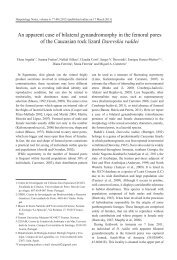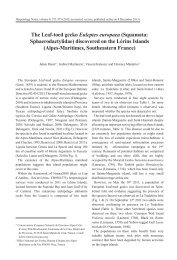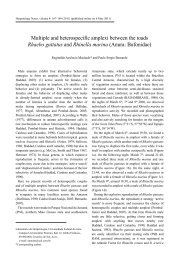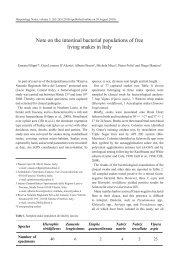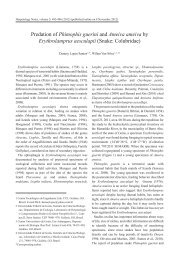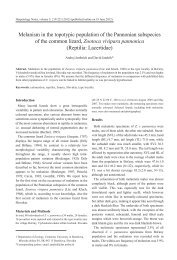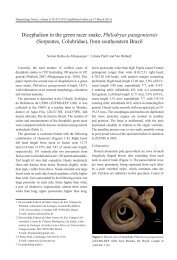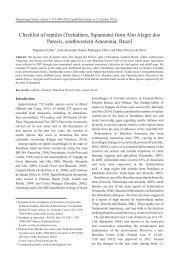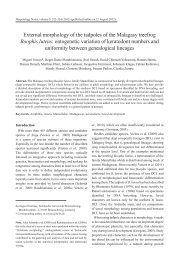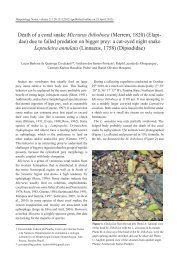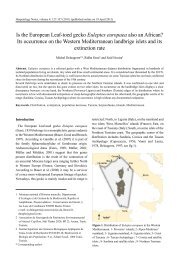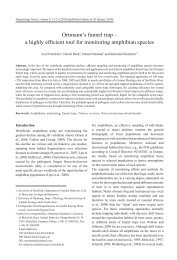Dasia olivacea - Herpetology Notes
Dasia olivacea - Herpetology Notes
Dasia olivacea - Herpetology Notes
Create successful ePaper yourself
Turn your PDF publications into a flip-book with our unique Google optimized e-Paper software.
<strong>Herpetology</strong> <strong>Notes</strong>, volume 4: 261-262 (2011) (published online on 4 August 2011)<br />
First record of <strong>Dasia</strong> <strong>olivacea</strong> Gray, 1839 (Squamata: Scincidae)<br />
from the mainland of Vietnam<br />
Peter Geissler 1 *, Duc Minh Hoang 2 and Truong Quang Nguyen 1,3<br />
At present six species of the genus <strong>Dasia</strong> Gray, 1839<br />
are recognized from Southeast Asia (Greer 1970,<br />
Inger & Brown 1980, Darevsky & Orlov 1994). These<br />
arboreal lygosomine skinks are widely distributed from<br />
Sri Lanka in the west to the Philippine Island of Palawan<br />
in the east. In the north the distribution is said to reach<br />
15°N in the m ainland, while the Indonesian island of<br />
Java forms the most southern part of its range (Smith<br />
1935, Bourret 2009).<br />
<strong>Dasia</strong> <strong>olivacea</strong> Gray, 1839, the type species of <strong>Dasia</strong><br />
Gray, 1839, is the most widespread species. It has been<br />
reported from the mainland Southeast Asia (Myanmar,<br />
Thailand, Laos, and Cambodia), islands of the Sunda<br />
archipelago (Borneo, Java, Sumatra, Pulau Siberut, Pulau<br />
Berhala, and Pulau Natuna), and some smaller offshore<br />
islands of Peninsular Malaysia (Pulau Tioman, Pulau<br />
Pinang [type locality], and Pulau Perhentian) (Smith<br />
1935, Taylor 1963, Lim & Lim 1999, Nguyen et al. 2009,<br />
Das 2010, Teynié & David 2010). The northernmost<br />
record of this species is Sakaerat Environmental<br />
Research Station (near 14°30’N, 101°55’ E,), Nakhon<br />
Ratchasima Province, eastern Thailand (Nahbitabhata et<br />
al. 2000). In Cambodia, <strong>Dasia</strong> <strong>olivacea</strong> is known from<br />
Cardamom Mountains: one locality near Chum Noab,<br />
Thmar Baing District, Koh Kong Province and a second<br />
on Dalai Mountain, Phnom Somkos Wildlife Sanctuary<br />
(12°25.233’N, 103°04.072’E) (Stuart & Emmett 2006,<br />
Neang et al. 2010). The presence of <strong>Dasia</strong> <strong>olivacea</strong><br />
in Laos is mentioned by Teynié & David (2010) but<br />
without a precise locality. In Vietnam, <strong>Dasia</strong> <strong>olivacea</strong><br />
was first recorded by Smith (1920) from “Pulo Condore”<br />
(now Con Dao Island), an offshore island in southern<br />
Vietnam. Darevsky (1990) subsequently reported this<br />
1 Zoologisches Forschungsmuseum Alexander Koenig,<br />
Adenauerallee 160, D-53113 Bonn, Germany;<br />
e-mail: pgeissler84@yahoo.de<br />
2 Centre for Biodiversity and Development, Institute of Tropical<br />
Biology, 85 Tran Quoc Toan, Ho Chi Minh City, Vietnam;<br />
3 Institute of Ecology and Biological Resources, 18 Hoang<br />
Quoc Viet, Hanoi, Vietnam.<br />
* Corresponding author.<br />
species from Cu Lao Panjang in the Gulf of Thailand<br />
and affirmed Smiths’ record from Con Dao Island<br />
(Darevsky 1999). The occurrence of <strong>Dasia</strong> <strong>olivacea</strong> on<br />
Phu Quoc Island, Kien Giang Province was stated by<br />
Bobrov and Semenov (2008) and Nguyen et al. (2009).<br />
The occurrence of <strong>Dasia</strong> <strong>olivacea</strong> in the Vietnamese<br />
mainland, as well as a postulated distribution on offshore<br />
islands in central Vietnam (Bobrov 1993) has not been<br />
documented in any recent herpetofaunistic works (e.g.,<br />
Bobrov & Semenov 2008, Nguyen et al. 2009). During<br />
recent surveys in southern Vietnam, three specimens of<br />
<strong>Dasia</strong> <strong>olivacea</strong> were observed in Dong Nai and Kien<br />
Giang provinces. All specimens fit to the descriptions<br />
of Smith (1935) and Taylor (1963) showing the typical<br />
colouration pattern of the species: Dorsum green with<br />
bronze scales in the dorsolateral areas; transverse bands<br />
of irregular greenish white ocelli edged by black and<br />
extending low on flanks; head dark olive with black<br />
markings; throat and ventral parts of body bluish<br />
and yellowish green (Fig. 1). Like in the Malaysian<br />
Figure 1. <strong>Dasia</strong> <strong>olivacea</strong> basking on a trunk of Cocos<br />
nucifera, Kien Giang Province, Southern Vietnam.<br />
Photograph: D.M.Hoang.
262<br />
Figure 2. Distribution of <strong>Dasia</strong> <strong>olivacea</strong> in Indochina and<br />
Thailand (black diamonds). New records from the mainland<br />
of Vietnam are marked with red triangles (scale bar in km).<br />
specimen depicted by Nguyen et al. (2009), Vietnamese<br />
specimens also have upper and lower eyelids edged in<br />
white (Fig. 1). The specimen from Dong Nai Province<br />
was found close to the headquarters of Cat Tien National<br />
Park, in an open deciduous gallery forest along the<br />
Dong Nai River (near 11°25’19.3’’N, 107°25’42.0’’E,<br />
104 m a.s.l.) This specimen was observed basking on a<br />
trunk of Lagerstroemia sp., about 3 m above the ground,<br />
in the afternoon of 10 May 2009. The second and third<br />
specimens from Kien Giang Province were found in Ba<br />
Trai Village, Binh An Commune, Kien Luong District<br />
(10 o 09’13.8”N, 104 o 38’05”E), on a coconut tree (Cocos<br />
nucifera) at a hight of about 3 m above ground in the<br />
morning of 24 July 2009. These habitats tally with the<br />
preference of the species for large trees and open forests<br />
like edges of clearings ore plantations (Das 2010).<br />
The currently known localities of <strong>Dasia</strong> <strong>olivacea</strong> from<br />
Indochina and Thailand are summarized in Fig. 2.<br />
Acknowledgements: We are indebted to Tran Van Thanh and<br />
the team of Cat Tien National Park (Dong Nai) for permissions<br />
and hospitality. We thank E. Sterling (New York) and K. Koy<br />
(Berkeley) for providing the map. PG thanks E. Galoyan, Nikolay<br />
N. Poyarkov, Igor Palko, Anja Vassilieva, Anton N. Chekanov,<br />
Vladimir A. Zryanin, Alexander Krohn, Le Duc Khanh, Jendrian<br />
Riedel, Bernd Geissler, and Rike Bach for their support during<br />
numerous field trips in Cat Tien. The field studies of PG were<br />
partly financed by the Alexander Koenig Society (AKG) and<br />
the German Herpetological Society (DGHT). The field study of<br />
Duc Minh Hoang was partly funded by the John and Catherine<br />
MacArthur Foundation (Project 09-92488-000-GSS).<br />
References<br />
Peter Geissler et al.<br />
Bobrov, V.V. (1993): Zoogeographic analysis of the lizard fauna<br />
(Reptilia, Sauria) of Vietnam. Zool. Zhur. 72(8): 70-79 (in<br />
Russian).<br />
Bobrov, V.V., Semenov, D.V. (2008): [Lizards of Vietnam]. Tovarishestvo<br />
Nauchnih Izdanii KMK, Moscow (in Russian).<br />
Bourret, R. (2009 [reprint]): Les Lézard de l’Indochine. Edition<br />
Chimaira, Frankfurt a. Main.<br />
Darevsky, I.S. (1990): <strong>Notes</strong> on the reptiles (Squamata) of some<br />
offshore islands along the coast of Vietnam. In: Vertebrates in<br />
the tropics, p. 125-129, Peters, G., Hutterer, R., Eds., Zool.<br />
Mus. A. Koenig, Bonn.<br />
Darevsky, I.S. (1999): The herpetofauna of some offshore islands<br />
of Vietnam, as related to that of the adjacent mainland. In: Tropical<br />
island herpetofauna: Origin, current diversity, and conservation,<br />
p. 27-42, Ota, H., Ed., Elsevier, Amsterdam.<br />
Darevsky, I.S., Orlov, N.L. (1994): Vietnascincus rugosus, a new<br />
genus and species of the <strong>Dasia</strong>-like arboreal skinks (Sauria,<br />
Scincidae) from Vietnam. Russ. J. Herpetol. 1(1): 37-41.<br />
Das, I. (2010): A field guide to the reptiles of South-East Asia.<br />
New Holland Publishers, London.<br />
Greer, A.E. (1970): The relationships of the skinks referred to the<br />
genus <strong>Dasia</strong>. Breviora 348: 1-30.<br />
Inger, R.F., Brown, W.C. (1980): Species of the Scincid Genus<br />
<strong>Dasia</strong> Gray. Fieldiana Zool. 3: 1-11.<br />
Lim, K.K.P., Lim, K.J. (1999): The terrestrial herpetofauna of<br />
Pulau Tioman, Peninsular Malaysia. Raffl. Bull. Zool. Suppl.<br />
6: 131-155.<br />
Nabhitabhata, J., Chan ard T., Chuaynkern, Y. (2000): Checklist<br />
of Amphibians and Reptiles in Thailand. Office of Environmental<br />
Policy and Planning, Bangkok.<br />
Neang, T., Grismer, L.L., Onn, C.K.; Grismer, J.L., Wood, P.L.Jr,<br />
Youmans, T.M. (2010): First report on the herpetofauna of Dalai<br />
Mountain in Phnom Samkos Wildlife Sanctuary, southwestern<br />
Cardamom Mountauns, Cambodia. Camb. J. Nat. Hist.<br />
2: 127-143<br />
Nguyen, V.S., Ho, T.C., Nguyen, Q.T. (2009): Herpetofauna of<br />
Vietnam. Edition Chimaira, Frankfurt am Main.<br />
Smith, M.A. (1920): Reptiles and batrachians collected on Pulo<br />
Condore. Jour. Nat. Hist. Soc. Siam 4: 93-97.<br />
Smith, M.A.. (1935): The Fauna of British India, including Ceylon<br />
and Burma, Reptilia and Amphibia, Vol. 2. Sauria. Taylor<br />
and Francis, London.<br />
Stuart, B.L., Emmett, D.A. (2006): A collection of amphibians<br />
and reptiles from the Cardamom Mountains, southwestern<br />
Cambodia. Fieldiana. Zool. 109: 1-27.<br />
Taylor, E.H. (1963): The Lizards of Thailand. Univ. Kansas Sci.<br />
Bull. 44(14): 687-1077.<br />
Teynié, A., David, P. (2010): Voyages naturalistes au Laos. Les<br />
reptiles. Revoir Editions (in French).<br />
Accepted by Zoltań T. Nagy



